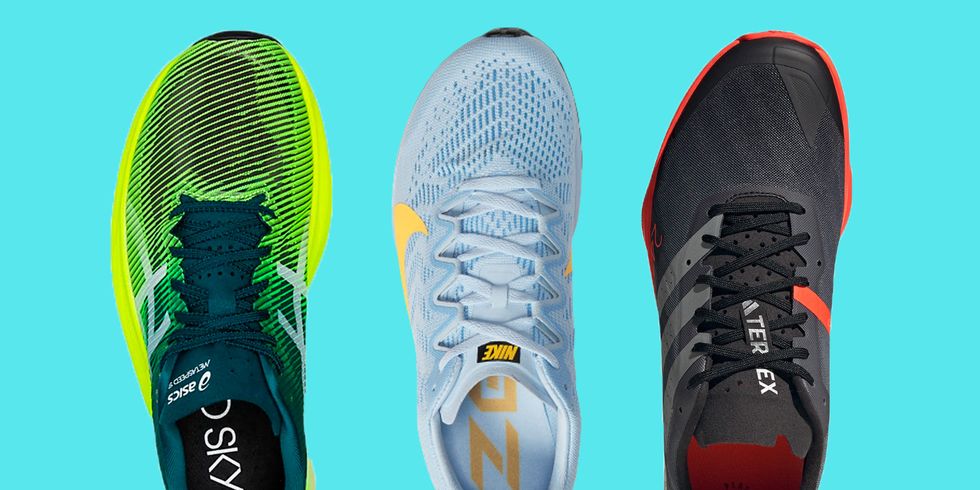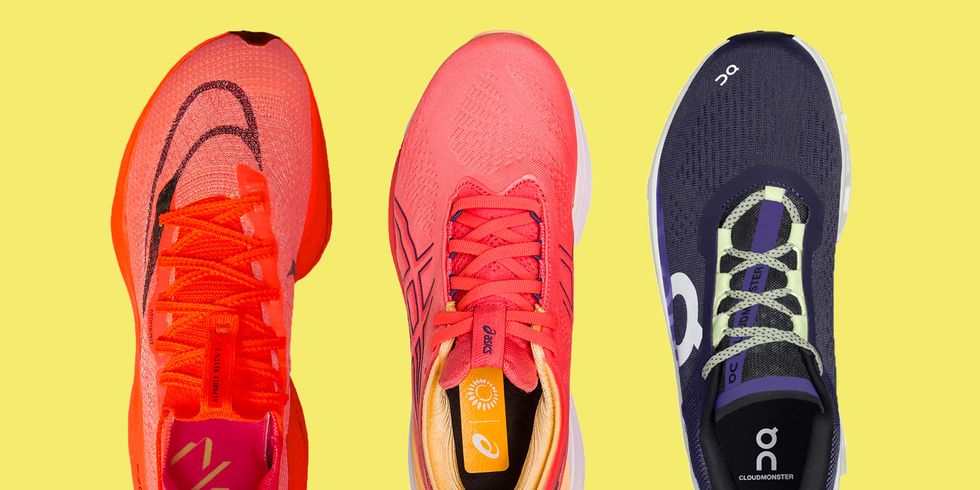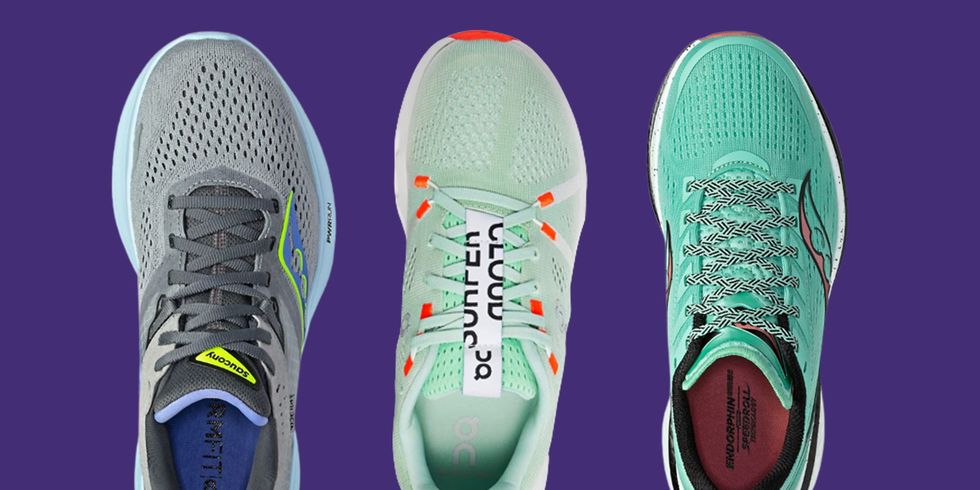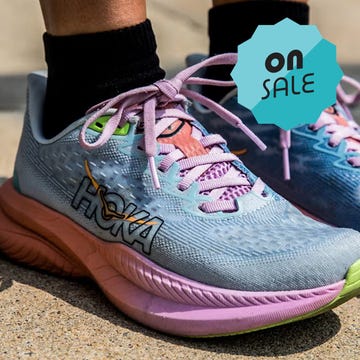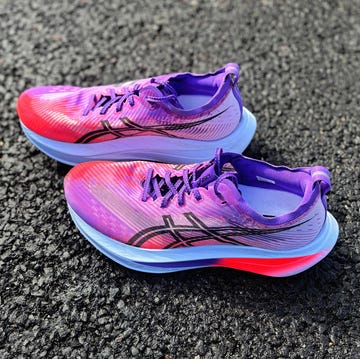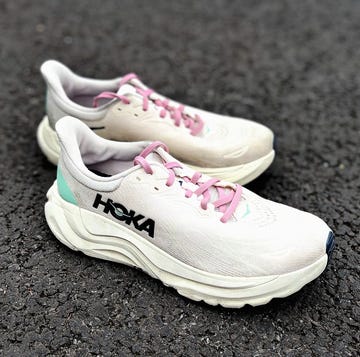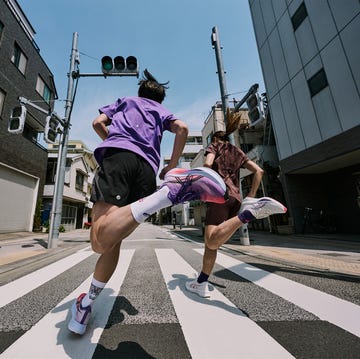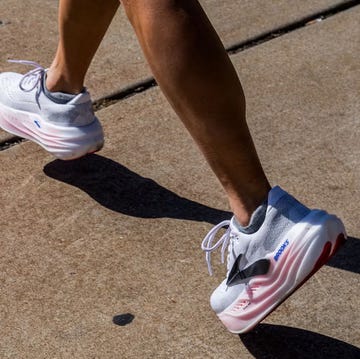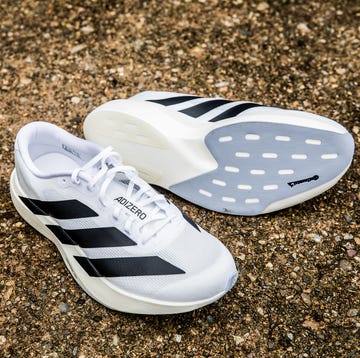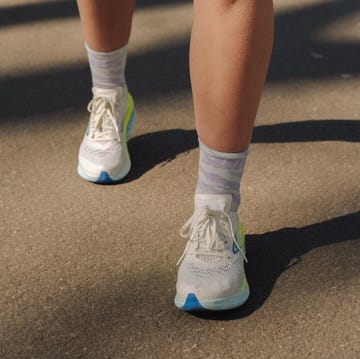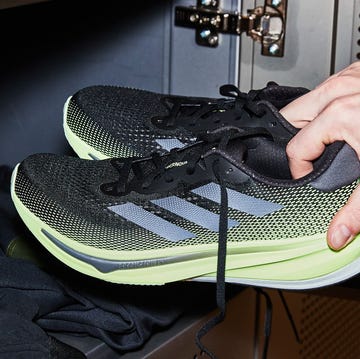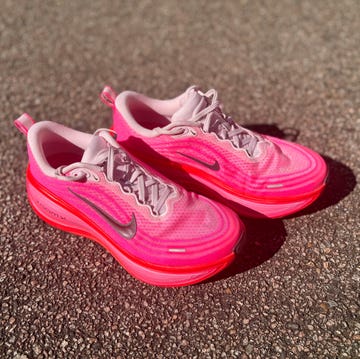When it comes to running shoes, it's hard to find a trainer that our team hasn’t put through its paces — whether it’s the latest iteration of a much-loved classic (like the Pegasus 40 or Gel-Kayano 29) or a surprising newcomer like the Flow Velociti Elite.
Now if you’re new to running, there’s nothing wrong with relying on one solid trainer for every run. But if you’re looking to get a bit more serious about your training, you might want to consider a shoe rotation. In short, this is where you use a different shoe for each type of running workout. There’s no set number for how many shoes you should have on the go at once, but sessions you might want to consider different shoes for include slow-paced runs like recovery runs and long, slow runs and faster efforts like tempo workouts and race days. If you're regularly running on trails, you'll need a trail shoe, too.
Check out our guide on how to build a shoe rotation for the full 101. But to give you some inspiration, we asked the Runner’s World editors for the shoes they’ve been reaching for time and time again.
What everyone's reading
Joe Mackie, deputy editor
- Preferred distance: Half Marathon
- Preferred terrain: Road and trail
- Gait: Neutral. Midfoot striker
Nike Invincible 3
The Invincible 3 is my go-to for easy, long and recovery days. The upper is built for snug comfort and underneath the huge hit of Zoom X midsole foam is formulated to give you an ultra plush, pillowy ride that takes the impact sting out of your miles but somehow still feels quite springy and responsive. They don’t feel too heavy for a max-cushioned shoe either. I actually rotate within my easy miles, also wearing the On Cloudsurfer which hits a similar forgiving with a bit of spring sweet spot but at a push I’d go for the Invincible.
Hoka Speedgoat 5
Although I’m a city runner I love getting off-road and I’m lucky to have some accessible trails close by, but there’s always a bit of road thrown in to get to, from and between them. Somehow the Speedgoat manage to work brilliantly on everything… they feel road-shoe soft and bouncy on the pavement and hardpack park trails, with Hoka’s lightweight cushioning and rocker to the fore. When trails get more technical, the Vibram outsole kicks in to deliver great traction and there’s a great balance between cushioning and protecting underfoot while also still delivering a great feeling of connection to the terrain. You feel like you want to run forever in these.
Nike Alphafly 2
I’m a big fan of the Under Armour Flow Velociti Elite for speedwork and tempo sessions as you get a super shoe speed kick combined with a low-profile, natural, almost racing flat feel. But when I’m racing I reach for the Alphafly 2. I’ve run PBs at various distances in them over the last six months or so and while I like to think that it’s not all down to the shoe, I’m entirely convinced that the unrivalled energy return from the huge slab of midsole foam and carbon has helped me to hold faster paces with less effort and, in marathons particularly, less accumulated hammering to the legs. Still the alpha super shoe for me.
Rick Pearson, senior editor
- Preferred distance: Half marathon
- Preferred terrain: On and off road
- Gait: Forefoot/midfoot striker, neutral
Asics Metaspeed Sky+
For race day and key sessions, I’m going for the Asics Metaspeed Sky+. It’s designed with forefoot strikers in mind, which suits me, and feels a little more stable than other supershoes I’ve tried. It’s lightweight (205g) and has a slightly lower heel-toe drop (5mm) than many of its competitors, which creates a more natural ride.
Nike Zoom Streak 7
Before the dawn of carbon plates, people were winning major races in the Nike Zoom Streak. It’s a low-profile, versatile racing flat that can be worn for distances from 5K to marathon. The Streak 6 was even better than the Streak 7, but is sadly no longer available (and I have looked). In terms of a road shoe that can serve almost all your needs without bankrupting you, it ticks every box.
Adidas Terrex Speed Ultra
I wasn’t expecting to like this shoe, as I hadn’t enjoyed other Terrex models, but the Speed Ultra is a revelation. Ultrarunner and Terrex athlete Tom Evans played an active role in its creation, and the result is a shoe that feels fast and comfortable across a variety of speeds and distances. It’s a trail shoe, but with a tread that can effortlessly handle road sections, and it looks snazzy too.
Ali Ball, ecommerce editor
- Preferred distance: Marathon
- Preferred terrain: Road
- Gait: Overpronation
Nike Alphafly Next% 2
For me, no race day shoe beats the Alphafly. I slightly overpronate when I run, and while I’ve run marathons in both the Vaporfly and Alphafly, the Alphafly give me that bit more stability. It’s seriously stacked, falling just under the World Athletics 40mm limit for sole thickness (not that I’ll be winning any competitions), so it might be a bit tippy for some. For me, I love the comfort and the propulsion, and you’ll find these on my feet for most races and interval sessions.
Asics Gel-Nimbus 25
I’m a sucker for a max-cushioned shoe, and it doesn’t get much plusher than the Gel-Nimbus 25. The bouncy foam midsole and stretchy knit tongue get a big thumbs up from me, and Asics has given the shoe a more fun, modern look since the previous iteration, too. Don’t expect to be hitting PBs in these, but for easy runs and recovery days they’re my winner.
On Cloudmonster
For when you want comfort combined with responsiveness, the Cloudmonster fits the bill. I often recommend this one to friends as a great beginner’s running shoe. Like the Gel-Nimbus, it’s classed as a max-cushioned trainer, but it feels a lot less plushy and a lot more versatile. This is largely due to the speedboard which gives the forefoot a certain snappiness for faster paces – perfect for adding some tempo to those longer runs.
Jen Bozon, deputy digital editor
Saucony Ride 16
I tend to do the bulk of my miles in the Saucony Guide 16s – wearing these for long weekend runs and easy recovery miles in the week. I’m someone that overpronates and can be quite prone to lower limb niggles so I found the structure they provide and their firm cushioning is great for me.
On Cloudsurfer 7
I like to wear the Cloudsurfer 7s for faster stuff – so interval sessions and tempo runs – as they’re light and energetic, so feel great when you want to pick up the pace, but soft as well, so just feel really comfortable to run in.
Saucony Endorphin Speed 3
I also wear the Saucony Endorphin Speed 3s for speed sessions – and think I will wear these for my next race. These have a nylon plate, which combined with the bouncy midsole foam feels really springy but not overly so that you feel out of control, which suits me well. Because of their ultra-light and bouncy cushioning they are also well suited to long miles, so I tend to stick these on if I’m doing a long run with fast efforts thrown in.
Kate Carter, commissioning editor
- Preferred distance: 5/10k
- Preferred terrain: Road or track
- Gait: Forefoot/midfoot striker, neutral
Asics Novablast 3
I run quite high mileage most of the time (up to about 70 miles a week) and that means a lot of runs where my poor ill-used, tired legs demand a bit of cushioning. I've got through a fair few pairs of these beautifully springy, neutral, energy-returning Novablast 3s and still love them. They just seem to give you that bit more bounce than other, every day, workhorse- style shoes.
Puma Deviate Nitro/ Puma Deviate Nitro Elite
Cheating really, as these are two different shoes, but they have a lot - as you'd expect from the names - in common and complement each other so well. The Deviate Nitro is a lightweight but cushioned training shoe; the Nitro Elite the race version with a carbon plate. The former are what I call "holiday shoes" e.g. if you can only pack one pair for a week that will include long, easy and speedwork runs, that's what you pack as they work for everything. The Nitro Elite have that extra spring from the plate but are also surprisingly comfortable and durable. I wore them for London Marathon and they were fantastic.
Adidas Adios Pro 3
Having always been a Nike runner (oh how I miss the original 4%!) I was surprised by just how much I loved the first Adios Pro and by version three, my love affair has been cemented. These are now the shoes I reach for on (road) race day. The propulsion is second-to-none and though they aren’t super stable - cornering at speed can be a tad hairy - they are perfect for your pancake flat road races and those PB attempts.
Alice Barraclough, commissioning editor
- Preferred distance: 10K
- Preferred terrain: Road or trails
- Gait: Neutral
Adidas Ultraboost Light
Stylish? Tick. Cushioned? Tick. Lightweight? Tick. I own more pairs of Adidas Ultraboost than I’d care to admit. So perhaps you won’t be surprised to learn that the latest iteration – the Adidas Ultraboost Light – is my go-to shoe for just throwing on for those seriously easy, chilled (and probably chatty) runs. With a snug sock-like fit that really hugs your foot, they’re the type of shoes you can pull on straight out of the box and not need to worry about blisters or rubbing. Sure, they’re not my fastest pair of shoes, but they are comfy, and they look just as good in the gym, out for brunch or even doing my weekly food shop, as they do when I’m out on a gentle 5K to blow the cobwebs away.
On Cloudmonster
For anything longer than a 5K, I often find myself pulling on a pair of On Cloudmonsters. Featuring maximalist cushioning, the Cloudmonster – true to its name – is a little bulky, but the 'monstrous' amount of foam means these shoes help to keep your feet feeling protected over longer distances. I actually find the cushioning in these quite firm and responsive (it’s not a cushy, soft recovery shoe). And despite originally thinking stones might get stuck in the ‘clouds’ on the outsole, they actually perform really well on the light gravel trail paths around my local park.
New Balance FuelCell SuperComp Elite v3
I wasn’t the biggest fan of this shoe’s predecessor – the New Balance FuelCell RC Elite v2 – since they gave me the worst blood blisters, but the SuperComp Elite v3 has won me over. Featuring a carbon plate, these lightweight and energetic running shoes are built for race day. In fact, these are the shoes I currently reach for speed sessions and PB attempts. I love how they gently push you forward when you ramp up your speed – and while they’re perhaps not as aggressive or propulsive as the Adidas Adios Pro 3’s – they feel a lot more stable and wearable.
Ben Hobson, executive editor, digital
- Preferred distance: Half marathon
- Preferred terrain: On and off road
- Gait: Forefoot/midfoot striker, neutral
Adidas Adizero Pro 3
It was a tough call between the Adizero Pro 3 and the Saucony Endorphin Elite when it comes to race-day shoes as I really enjoy running in both, but the cheaper cost of the Pro 3 makes them my choice (they’re still not cheap though). They offer a slightly firmer ride compared with other high-stack/carbon assisted shoes and as a bigger runner (85kg), I prefer that feeling under foot, rather than too much squidge, as you get a bit more sense of feedback from the road.
Reebok Floatride Energy
From version one of this shoe, I’ve been telling anyone who will listen that the Reebok Floatride Energy is a great do-it-all running shoe that you can get cheap. Version 5 sticks to the same principle and is a very capable everyday running shoe; it’s comfy, light, offers a very smooth and easy running experience and can handle most training sessions with ease.
Salomon Speedcross
I’m fortunate enough to live near Epping Forest in East London/Essex and it’s got some brilliant trails and a real variety of terrain, but is also notoriously muddy for a lot of the year and I’ve found the Salomon Speedcross strikes that perfect balance between grip in the really sloppy stuff and comfort on the drier bits. There’s even a GORE-TEX version, which means those longer, wetter runs aren’t so soggy.


